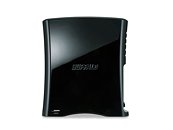Monday, September 28th 2009

Buffalo Announces USB 3.0 DriveStation External HDD
Buffalo Japan is ready with its first external hard drive that uses the new USB 3.0 interface to eliminate the bandwidth bottleneck posed by the older generation of the interface. The Buffalo DriveStation HD-HXU3, with its USB 3.0 SuperSpeed interface comes in capacities of 1 TB, 1.5 TB and 2 TB. The drive offers transfer rates of around 125 MB/s, on par with drives connected using the eSATA interface. The advantage of this however, is its seamless backwards compatibility with older USB 2.0 generation of the USB interface. The company has also announced the IFC-PCIE2U3 USB 3.0 controller. The two are expected to be available in Q4.
Source:
Softpedia

32 Comments on Buffalo Announces USB 3.0 DriveStation External HDD
Finally - Somebody is getting with the swing of things.
Good on 'ya Buffalo
USB 3.0 has more excitement for me, as its going to be more mainstream - at last, i wont be stuck with crap 30MB/s speeds when i plug my externals in to OEM machines...
(then again, we all better build a bunker to survive teh onslaught of new ipods with USB3.0 support.... FASTER THAN EVER BEFORE!)
Its all about creating a "UNIVERSAL SERIAL BUS" so that we don't have to have 15 different types of cables & connections, and so that the tech industry can develop on a wide scale for one simple multi-platform connection system without having to continuously fall back on far more expensive proprietary interface systems.
A bus that serves ALL needs without any regard as to weather it is storage, or human interface, or printing or machining, and USB 3 is just the next evolution of that attempt at universal communication that pays a little more attention to more recent, high Data rate devices.
The fact that these new advances also happen to provide better avenues for external storage are almost coincidental (although granted, very convenient).
These data rates are essential for a number of other advanced applications such as seriously large , high resolution industrial printing, HD video peripherals, heck even High-Def CNC machining or 3D Printing, and a thousand other uses.
And that's before we even begin to look at medical applications.
Computers do a HELL OF A LOT MORE in this world than burn movies & play world of warcraft, and its those thousands of other absurdly more important applications that advances like USB3 are intended to help advance.
If they Help Razor get a mouse up to 4,096,000Dpi, or Creative make a 44 Channel external sound card, or yes even replace an external storage interface like eSata, then that's just a bonus.
AFAIK this is the same for a USB Keyboard, and significantly worse for a PS2 Mouse / Kbd.
You can get a tool to check your own lag here : www.brothersoft.com/mouse-rate-checker-175872.html
And a tool to change this here : www.softpedia.com/get/Tweak/System-Tweak/USB-Mouserate-switcher.shtml
BUT IT S NOT RECOMMENDED - As it will also generate a schyteload more bus traffic and uses more CPU time as most cheap-ass onboard USB chips are CPU-supported.
EDIT : And Sorry Dude, I'm not picking on YOU specifically , I've just seen many similar posts popping up allover the place and somebody has to set the record straight.
i'm not entirely sure that program is accurate.
Only the highest value really counts (Your peak IS your poll rate) - the low values are just a side effect of slow movement or lack of movement (When there is no motion to mention, a mouse stops mentioning it - as every poll sent back from the mouse does actually use processor time).
The sensor only reports IF it sees a difference, and at high enough poll rate, if you move slow enough it may see no difference at all for 3 or 4 effective polls in a row (Remember yer mouse is polling at 500 effective polls / second ) and hence appear to be responding slower :)
Some high end mice do replace the native drivers with newer, faster ones, and this can help in mouse response/resolution.
Other ppl include this patch in other forms of system "all-in-one"' optimizer packs, but on an older single-core system this can actually be very harmful to your performance, as your processor still has to deal with all of these responses from the mouse, and the faster they come the more work to do.
yay for logitech :P
tested with a cheap, antique MS mouse - 125Hz
seems like logitech (at least on the high end mice) quadruple the refresh rate.
Fun test : Get an old PC single core if you can - open task manager - look at CPU load graph and spazz your mouse allover the place... I've seen as much as 20% load on older pentiums, depending on how crap the MoBo controller / mouse drivers where...
But on a newer quad, for example, its totally insignificant - there's PLENTY of spare MHz for the mouse data to completely disappear in ...
also, thread derailment >.<
Be fun when the first USB3.0 mice come out and we start comparing :D
I meant 'G9' but I do have a G7 the same as yours.